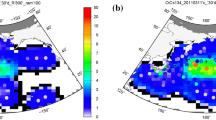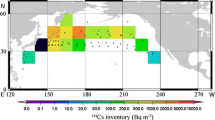Abstract
Activities of radiocaesium released by the Fukushima Dai-ichi Nuclear Power Plant (FNPP1) accident were measured by surface sampling at 408 stations and in vertical profiles at 24 stations in the North Pacific Ocean, and time-series samples were collected at two coastal stations. After July 2012, 137Cs activity in the surface water near FNPP1 remained around 1000 Bq m−3, which corresponds to a discharge rate of about 10 GBq day−1. FNPP1-derived radiocaesium spread eastward in surface water across the mid-latitude North Pacific with a speed of 7 km day−1 (8 cm s−1) until March 2012, and of 3 km day−1 (3.5 cm s−1) from March 2012 through August 2014. In June 2012, 134Cs activity reached a maximum of 6.12 ± 0.50 Bq m−3 at a 151-m depth (potential density, σ θ = 25.3 kg m−3) at 29°N, 165°E. This subsurface maximum, which was also observed along 149°E, might reflect the southward transport of FNPP1-derived radiocaesium in association with the formation and subduction of subtropical mode water (STMW). In June 2012 at 34°N–39°N along 165°E, 134Cs activity showed a maximum at around σ θ = 26.3 kg m−3, which corresponds to central mode water (CMW). 134Cs activity was higher in CMW than in any of the surrounding waters, including STMW. These observations also indicate that the most effective pathway by which FNPP1-derived radiocaesium is introduced into the ocean interior on a 1-year time scale is CMW formation and subduction.





Similar content being viewed by others
References
Aoyama M, Hirose K (1995) The temporal and spatial variation of 137Cs concentration in the western North Pacific and its marginal seas during the period from 1979 to 1988. J Environ Radioact 29:57–74. doi:10.1016/0265-931X(94)00050-7
Aoyama M, Hirose K (2004) Artificial radionuclides database in the Pacific Ocean: HAM database. Sci World J 4:200–215. doi:10.1100/tsw.2004.15
Aoyama M, Hirose K (2008) Radiometric determination of anthropogenic radionuclides in seawater. In: Pavel PP (ed) Radioactivity in the environment. Elsevier, Oxford, pp 137–162. doi:10.1016/S1569-4860(07)11004-4
Aoyama M, Hirose K, Nemoto K et al (2008) Water masses labeled with global fallout 137Cs formed by subduction in the North Pacific. Geophys Res Lett 35:L01604. doi:10.1029/2007GL031964
Aoyama M, Fukasawa M, Hirose et al (2011) Cross equator transport of 137Cs from North Pacific Ocean to South Pacific Ocean (BEAGLE2003 cruises). Prog Oceanogr 89:7–16. doi:10.1016/j.pocean.2010.12.003
Aoyama M, Tsumune D, Hamajima Y (2012a) Distribution of 137Cs and 134Cs in the North Pacific Ocean: impacts of the TEPCO Fukushima-Daiichi NPP accident. J Radioanal Nucl Chem. doi:10.5194/bg-10-3067-2013
Aoyama M, Tsumune D, Uematsu M et al (2012b) Temporal variation of 134Cs and 137Cs activities in surface water at stations along the coastline near the Fukushima Dai-ichi Nuclear Power Plant accident site, Japan. Geochem J 46:321–325. doi:10.2343/geochemj.2.0211
Aoyama M, Uematsu M, Tsumune et al (2013) Surface pathway of radioactive plume of TEPCO Fukushima NPP1 released 134Cs and 137Cs. Biogeosciences 10:3067–3078. doi:10.5194/bg-10-3067-2013
Bailly du Bois P, Laguionie P, Boust D et al (2012) Estimation of marine source-term following Fukushima Dai-ichi accident. J Environ Radioact 114:2–9. doi:10.1016/j.jenvrad.2011.11.015
Buesseler K, Aoyama M, Fukasawa M (2011) Impacts of the Fukushima nuclear power plants on marine radioactivity. Environ Sci Technol 45:9931–9935. doi:10.1021/es202816c
Buesseler KO, Jayne SR, Fisher NS et al (2012) Fukushima-derived radionuclides in the ocean and biota off Japan. Proc Natl Acad Sci USA 109:5984–5988. doi:10.1073/pnas.1120794109
Chino M, Nakayama H, Nagai H et al (2011) Preliminary estimation of release amounts of 131I and 137Cs accidentally discharged from the Fukushima Daiichi nuclear power plant into the atmosphere. J Nucl Sci Technol 48:1129–1134. doi:10.1080/18811248.2011.9711799
Hamajima Y, Komura K (2004) Background components of Ge detectors in Ogoya underground laboratory. Appl Radiat Isot 61:179–183. doi:10.1016/j.apradiso.2004.03.041
Hirose K, Aoyama M, Igarashi Y et al (2005) Ultra-sensitive mass spectrometric and other methods applied to environmental problems. J Radioanal Nucl Chem 263:349–353. doi:10.1007/s10967-005-0061-x
Honda MC, Aono T, Aoyama M et al (2012) Dispersion of artificial caesium-134 and-137 in the western North Pacific 1 month after the Fukushima accident. Geochem J 46:e1–e9. doi:10.2343/geochemj.1.0152
Inoue M, Kofuji H, Hamajima Y, Nagao S, Yoshida K, Yamamoto M (2012a) 134Cs and 137Cs activities in coastal seawater along Northern Sanriku and Tsugaru Strait, northeastern Japan, after Fukushima Dai-ichi Nuclear Power Plant accident. J Environ Radioactiity 111:116–119. doi:10.1016/j.jenvrad.2011.09.012
Inoue M, Kofuji H, Nagao S et al (2012b) Low levels of 134Cs and 137Cs in surface seawaters around the Japanese Archipelago after the Fukushima Dai-ichi Nuclear Power Plant accident in 2011. Geochem J 46:311–320. doi:10.2343/geochemj.2.0218
Kaeriyama H, Ambe D, Shimizu Y et al (2013) Direct observation of 134Cs and 137Cs in surface seawater in the western and central North Pacific after the Fukushima Dai-ichi Nuclear Power Plant accident. Biogeosci Discuss 10:1993–2012. doi:10.5194/bg-10-4287-2013
Kaeriyama H, Ambe D, Shigenobu Y et al (2014a) 134Cs and 137Cs in seawater around Japan after the Fukushima Daiichi nuclear power plant accident. doi:10.5928/kaiyou.23.127
Kaeriyama H, Shimizu Y, Ambe D et al (2014b) Southwest intrusion of 134Cs and 137Cs derived from the Fukushima Dai-ichi Nuclear Power Plant accident in the Western North Pacific. Environ Sci Technol 48:3120–3127. doi:10.1021/es403686v
Kameník J, Dulaiova H, Buesseler KO et al (2013) Cesium-134 and 137 activities in the central North Pacific Ocean after the Fukushima Dai-ichi Nuclear Power Plant accident. Biogeosci Discuss 10:5223–5244. doi:10.5194/bg-10-6045-2013
Kanda J (2013) Continuing 137Cs release to the sea from the Fukushima Dai-ichi Nuclear Power Plant through 2012. Biogeosci Discuss 10:3577–3595. doi:10.5194/bg-10-6107-2013
Karasev EV (2011) Monitoring of ecological conditions of the Far East Seas. In: Consortium A-O (ed) The 2nd international meeting of Amur-Okhotsk Consortium 2011, Amur-Okhotsk Consortium, Hokkaido University, Japan, pp 75–80
Katata G, Chino M, Kobayashi T et al (2015) Detailed source term estimation of the atmospheric release for the Fukushima Daiichi nuclear power station accident by coupling simulations of an atmospheric dispersion model with an improved deposition scheme and oceanic dispersion model. Atmos Chem Phys 15:1029–1070. doi:10.5194/acp-15-1029-2015
Kim CK, Byun JI, Chae JS et al (2012) Radiological impact in Korea following the Fukushima nuclear accident. J Environ Radioact 111:70–82. doi:10.1016/j.jenvrad.2011.10.018
Kobayashi T, Nagai H, Chino M et al (2013) Source term estimation of atmospheric release due to the Fukushima Dai-ichi Nuclear Power Plant accident by atmospheric and oceanic dispersion simulations. J Nucl Sci Technol 50:255–264. doi:10.1080/00223131.2013.772449
Kumamoto Y, Murata A, Kawano T et al (2013) Fukushima-derived radiocaesium in the northwestern Pacific Ocean in February 2012. Appl Radiat Isot 81:335–339. doi:10.1016/j.apradiso.2013.03.085
Kumamoto Y, Aoyama M, Hamajima Y et al (2014) Southward spreading of the Fukushima-derived radiocaesium across the Kuroshio Extension in the North Pacific. Sci Rep 4:4276. doi:10.1038/srep04276
Lutter G, Tzika F, Hult M et al (2015) Measurement of anthropogenic radionuclides in post-Fukushima Pacific seawater samples. Nukleonika. doi:10.1515/nuka-2015-0112
Miyazawa Y, Masumoto Y, Varlamov SM et al (2012) Inverse estimation of source parameters of oceanic radioactivity dispersion models associated with the Fukushima accident. Biogeosci Discuss 9:13783–13816. doi:10.5194/bg-10-2349-2013
Oka E (2009) Seasonal and interannual variation of North Pacific subtropical mode water in 2003–2006. J Oceanogr 65:151–164
Oka E, Qiu B (2012) Progress of North Pacific mode water research in the past decade. J Oceanogr 68:5–20
Oka E, Suga T (2005) Differential formation and circulation of North Pacific central mode water. J Phys Oceanogr 35:1997–2011
Oka E, Kouketsu S, Toyama K, Uehara K, Kobayashi T, Hosoda S, Suga T (2011) Formation and subduction of central mode water based on profiling float data, 2003–08. J Phys Oceanogr 41:113–129
Povinec PP, Aoyama M, Fukasawa M et al (2011) 137Cs water profiles in the South Indian Ocean—an evidence for accumulation of pollutants in the subtropical gyre. Prog Oceanogr 89:17–30. doi:10.1016/j.pocean.2010.12.004
Sanchez-Cabeza JA, Levy I, Gastaud J, Eriksson M et al (2011) Transport of North Pacific 137Cs labeled waters to the south-eastern Atlantic Ocean. Prog Oceanogr 89:31–37. doi:10.1016/j.pocean.2010.12.005
Smith JN, Brown RM, Williams WJ et al (2014) Arrival of the Fukushima radioactivity plume in North American continental waters. Proc Natl Acad Sci. doi:10.1073/pnas.1412814112
Stohl A, Seibert P, Wotawa G (2012a) The total release of xenon-133 from the Fukushima Dai-ichi Nuclear Power Plant accident. J Environ Radioact 112:155–159. doi:10.1016/j.jenvrad.2012.06.001
Stohl A, Seibert P, Wotawa G et al (2012b) Xenon-133 and caesium-137 releases into the atmosphere from the Fukushima Dai-ichi Nuclear Power Plant: determination of the source term, atmospheric dispersion, and deposition. Atmos Chem Phys 12:2313–2343. doi:10.5194/acp-12-2313-2012
Terada H, Katata G, Chino M et al (2012) Atmospheric discharge and dispersion of radionuclides during the Fukushima Dai-ichi Nuclear Power Plant accident. Part II: verification of the source term and analysis of regional-scale atmospheric dispersion. J Environ Radioact 112:141–154. doi:10.1016/j.jenvrad.2012.05.023
The-2011-Tohoku-Earthquake-Tsunami-Joint-Survey-Group (2011) Nationwide field survey of the 2011 off the Pacific coast of Tohoku earthquake tsunami. J Jpn Soc Civil Eng Ser B2 (Coastal Engineering) 67:63–66
Tsumune D, Aoyama M, Hirose K et al (2011) Transport of 137Cs to the southern hemisphere in an ocean general circulation model. Prog Oceanogr 89:38–48. doi:10.1016/j.pocean.2010.12.006
Tsumune D, Tsubono T, Aoyama M et al (2012) Distribution of oceanic 137Cs from the Fukushima Dai-ichi Nuclear Power Plant simulated numerically by a regional ocean model. J Environ Radioact 111:100–108. doi:10.1016/j.jenvrad.2011.10.007
Tsumune D, Tsubono T, Aoyama M et al (2013) One-year, regional-scale simulation of 137Cs radioactivity in the ocean following the Fukushima Daiichi nuclear power plant accident. Biogeosciences 10:5601–5617
Yoshida S, Macdonald A, Jayne S et al (2015) Observed eastward progression of the Fukushima 134Cs signal across the North Pacific. Geophys Res Lett. doi:10.1002/2015GL065259
Acknowledgments
This study was supported in part by the "Radioactive Survey and Research Fund" of the Ministry of Education, Culture, Sports, Science and Technology (MEXT), Japan (Houshanou-chousa-kenkyuhi, FY2011–2014) and in part by the J-RAPID fund of the Japan Science and Technology Agency for the project entitled “Investigation and Prediction of Impacts of the 2011 off the Pacific coast of Tohoku Earthquake on Marine Environment, FY2011–2012”. The authors thank Takashi Ishimaru for water sampling during the UM1103 cruise of the Umitaka-maru, Toshitaka Gamo for water sampling during the KT1106 cruise of the Tansei-maru, researchers at the Marine Division of the Japan Meteorological Agency for water sampling during cruises KS1202 and KS1205 of the Keifu-maru and the RF1205 cruise of the Ryofu-maru. We thank the commercial ship company, captains and crew of VOS ships for their voluntary work to collect surface seawater samples. We also thank Satoshi Nakamura for his kind collaboration to collect seawater samples at the research pier of Hazaki Oceanographical Research Station of the Port and Airport Research Institute. We also thank you Junko Inomata for his support to collect seawater samples at Tomioka. A part of coastal observations at Tomioka and Hasaki presented in this article was supported by EC 7th Framework project COMET-FRAME (COordination and iMplementation of a pan-Europe instrumenT for radioecology) (Grant Agreement Number 604974) and a Marine Project of Institute of Environmental Radioactivity, Fukushima University, Japan. We also thank Tomomi Onda, Aoi Mori, Yukiko Suda, and Tomoko Kudo for creating the database, drawing graphs, and making tables for this paper.
Author information
Authors and Affiliations
Corresponding author
Electronic supplementary material
Below is the link to the electronic supplementary material.
Rights and permissions
About this article
Cite this article
Aoyama, M., Hamajima, Y., Hult, M. et al. 134Cs and 137Cs in the North Pacific Ocean derived from the March 2011 TEPCO Fukushima Dai-ichi Nuclear Power Plant accident, Japan. Part one: surface pathway and vertical distributions. J Oceanogr 72, 53–65 (2016). https://doi.org/10.1007/s10872-015-0335-z
Received:
Revised:
Accepted:
Published:
Issue Date:
DOI: https://doi.org/10.1007/s10872-015-0335-z




